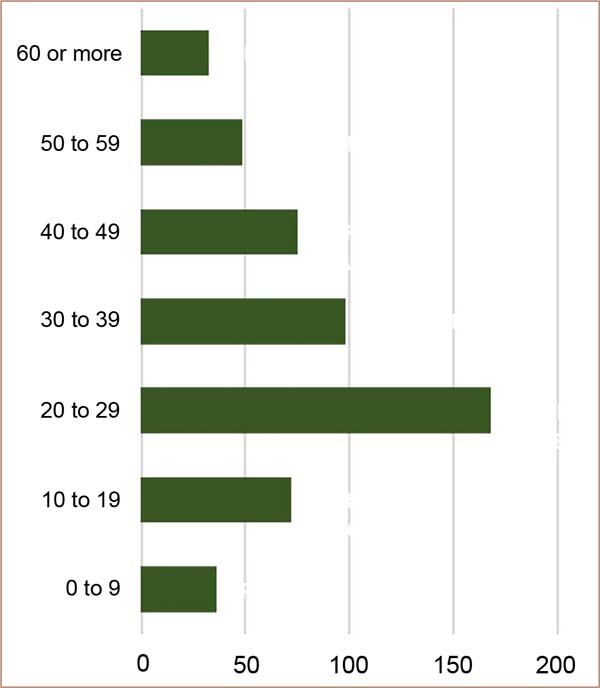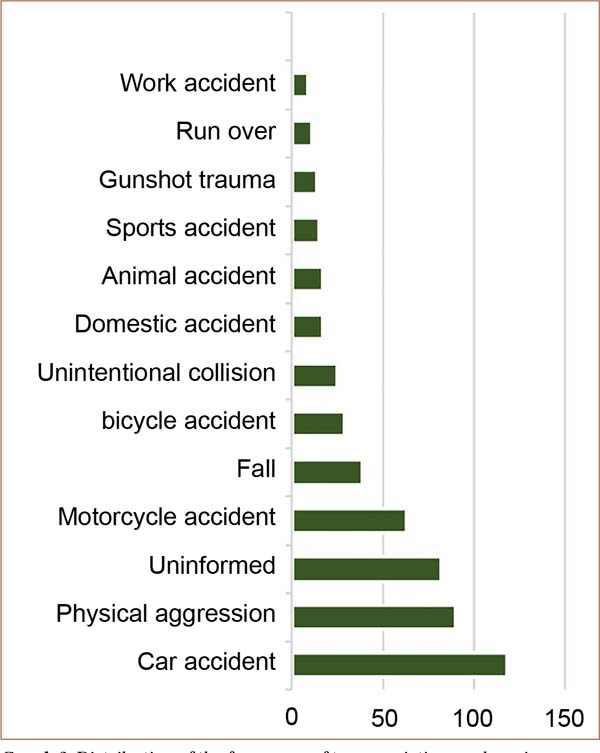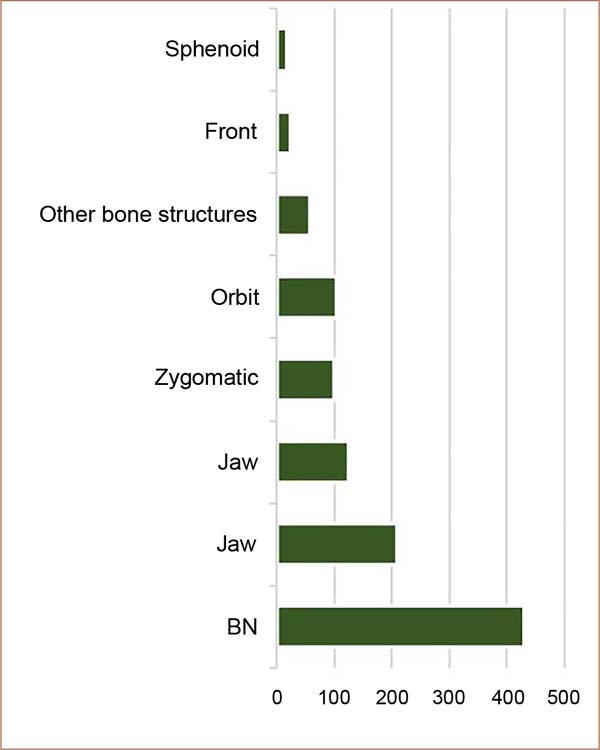INTRODUCTION
The panorama of trauma remains alarming in Brazil; of the ten main causes of death
in
the country’s population between the years 2000 and 2019, estimated by the World
Health Organization (WHO), trauma was present in the fourth and eighth positions,
respectively represented by interpersonal violence and traffic accidents. However,
considering only deaths between 1 and 40 years of age, trauma leads to deaths,
occupying all the first places with interpersonal violence, traffic accidents,
self-inflicted injuries, and drownings1.
In addition to deaths, trauma is also cruel to survivors. There is a significant
financial burden on the victim and their family, with incapacitation that generates
billions in expenses for the health system, the social security system, and society
as a whole2. For example, in 2016,
traffic accidents alone caused 180,443 hospitalizations, at a cost of R$253.2
million for the SUS3.
In this context, head and facial traumas are among the most worrying, as they
represent almost half of traumatic deaths, and many of these victims do not even
survive to be treated. Facial trauma represents 7.4% to 8.7% of emergency care
and
requires expensive multidisciplinary work4.
It is essential to emphasize that the face is an anatomical region that presents many
unique anatomical structures, responsible for essential functions such as chewing,
swallowing, communication, and breathing5. Thus, traumatic injuries in this area become a survival
challenge for the patient and a therapeutic challenge for health professionals,
who
need to reconstruct the functional and aesthetic aspects that sometimes require
multiple surgical procedures4.
OBJECTIVE
Due to the relevance of facial trauma, its scientific understanding in its diverse
regional realities becomes imperative, raising diagnoses and interventions that
improve prevention and preparation of health services since controlling the quality
of care is essential for the reduction of deaths and preventable
complications6. Therefore,
this study aims to evaluate the epidemiology of facial trauma care undergoing
surgery at the Hospital de Clínicas da Universidade Federal do Triângulo Mineiro
(HC-UFTM) in Uberaba-MG.
METHOD
The HC-UFTM Research Ethics Committee approved the study under opinion 4,940,424.
This is an observational, longitudinal, and retrospective study conducted based
on
the analysis of the medical records of patients who suffered facial trauma and
underwent surgery by the Plastic Surgery team at HC-UFTM between 2010 and 2019.
The
following information was selected for patients: age and sex, trauma mechanism,
fractured bones, other traumatized body regions, number of surgeries, surgical
procedure adopted, length of stay, and deaths.
After data collection, patient and trauma characteristics were statistically compared
with the following outcomes: death, length of stay, and need for multiple surgeries.
The descriptive evaluation was constructed using absolute frequencies and
percentages for categorical variables and mean, standard deviation (mean ± SD),
median, and percentiles for numerical variables. The analytical evaluation was
carried out using Fisher’s exact test. The margin of error used in the statistical
tests was 5%. The data were entered into an Excel spreadsheet, and the program
used
to obtain statistical calculations was IBM SPSS, version 23.
RESULTS
During the period from 2010 to 2019, 632 surgical procedures were found in 529
patients who were victims of facial trauma treated by the Plastic Surgery team
at
HC-UFTM. Among the 529 medical records included in the study and analyzed, 376
(71.08%) were previously scheduled surgeries, and the remainder, 153 (28.92%),
were
emergency surgeries. Regarding the sex of the patients, 415 (78.45%) were men
and
114 (21.55%) were women. The age group was divided into 10 groups of 10 years,
ranging from 0 to 99 years. Among these groups, trauma was more frequent in
individuals aged 20 to 29 years, which corresponds to 168 (31.76%) of the total
cases. The second most frequent group was 30 to 39 years old, with 98 (18.53%)
cases, as shown in Graph 1.
Graphic 1 - Distribution of the frequency of trauma victims undergoing surgery at
the Hospital de Clínicas da Universidade Federal do Triângulo Mineiro
between 2010 and 2019 by age group.
Graphic 1 - Distribution of the frequency of trauma victims undergoing surgery at
the Hospital de Clínicas da Universidade Federal do Triângulo Mineiro
between 2010 and 2019 by age group.
In relation to the etiology of the trauma, several groups of events were verified,
with most incidents being automobile accidents (22.31%), assaults (17.01%), and
motorcycle accidents (11.91%). In 82 (15.5%) of the medical records analyzed,
the
etiology of the patient’s facial trauma was not clearly stated, as shown in Graph 2.
Graph 2 - Distribution of the frequency of trauma victims undergoing surgery at
the Hospital de Clínicas da Universidade Federal do Triângulo Mineiro
between 2010 and 2019 by trauma event.
Graph 2 - Distribution of the frequency of trauma victims undergoing surgery at
the Hospital de Clínicas da Universidade Federal do Triângulo Mineiro
between 2010 and 2019 by trauma event.
Another topic researched in the medical records was the presence and type of
craniofacial fracture. In 28 (5.29%) of the medical records researched, no fractures
were identified. In the remaining 501 (94.71%) cases, there was a fracture, and
the
most affected bones were bones of the nose (BN), with 430 (80%) cases, and the
jaw,
with 210 (39%) cases, according to shows Graph 3. In this context, in 319 (63.67%) of the cases, there was a fracture of
just one facial bone, and in 182 (36.33%) more than one bone was fractured.
Graph 3 - Distribution of the frequency of fractured bone structures in trauma
victims undergoing surgery at the Hospital de Clínicas da Universidade
Federal do Triângulo Mineiro between 2010 and 2019.
Graph 3 - Distribution of the frequency of fractured bone structures in trauma
victims undergoing surgery at the Hospital de Clínicas da Universidade
Federal do Triângulo Mineiro between 2010 and 2019.
Another piece of information researched in the medical records was the existence of
traumatic injuries in parts of the body other than the face. It was found that
in
359 (67.86%) cases, the facial trauma was isolated, and in 161 (30.43%) cases,
there
was trauma in another region of the body. Furthermore, 9 (1.70%) records did not
have information regarding this topic.
We also researched the surgical procedures performed on these patients. Thus, it was
found that the most frequent surgery was to reduce nasal fractures, which appeared
in 189 (35.72%) medical records, followed by osteosynthesis of complex jaw
fractures, performed in 171 (32.33%) of patients. The third most performed procedure
was osteosynthesis of complex panfacial fractures in 44 (8.32%) of the cases
analyzed. The other procedures performed alone did not reach more than 5%
incidence.
Furthermore, the number of procedures to which patients were subjected was also
investigated. It was found that in 452 (85.44%) cases, only one surgery was
necessary; in 71 (13.42%) cases, two surgeries were necessary; and in 6 (1.13%)
patients, three or more surgeries were necessary. The length of stay was recorded
in
524 of the 529 medical records, and the calculated average was 7 days.
DISCUSSION
Trauma represents one of the main public health problems in the world7, being the cause of death of around
5.8 million people per year8. Among
these deaths, 50% result from trauma to the face and head2. In Brazil, the situation repeats itself, and trauma
has a strong impact on the morbidity and mortality of the population9. In view of this, the relevance of
facial trauma for health systems and for the definition of political actions
regarding trauma treatment and prevention is undeniable.
Furthermore, a fundamental factor to be considered is that injuries to the facial
region can considerably change the quality of life of those injured in terms of
appearance and self-esteem10.
Facial traumas have emotional, functional, and aesthetic repercussions and,
therefore, if not properly treated, they leave consequences, marginalizing the
individual from social life and generating incapacity for work11.
Regarding this data, it is important to highlight that the highest incidence found
in
this study and in the other studies analyzed was in the working age range, mainly
in
the third decade of life, as found by Ramos et al.2 and Cuéllar Gutiérrez et al.3
Regarding gender, this study found a significant prevalence of males compared to
females, with 78.45% of patients being men. This finding corroborates other studies
on this topic, which also showed a higher incidence of facial trauma in men, as
attested by Pinheiro et al.12 The
prevalence in males can be explained by the fact that men drive more frequently,
as
well as use drugs and get more involved in fights.13
The analysis of the etiology of the trauma found that the most frequent mechanism
was
the car accident, followed by physical aggression. This data corresponds to other
studies in Brazilian literature on the topic carried out in large reference
centers12,14,15.
Traffic-related etiologies (car accidents, motorcycle accidents, bicycle accidents,
and being run over) together account for 41.78% of the cases in this study. The
study conducted by Carvalho et al.11 observed a correlation between alcohol consumption and facial
trauma resulting from a car accident in 41.1% of victims. However, as highlighted
by
Martins et al.16, this data is
often neglected by the victim care team, which compromises the objectivity of
this
data in Brazilian literature. Other studies also found physical aggression as
the
second most frequent etiological factor in facial trauma2,16,17.
In relation to fractured bone structures, a very significant prevalence of the nasal
bones (BN) was found, affected in 85.83% of cases, as shown by other studies on
the
subject2,18,19. Due to
its prominence on the face, associated with the fragility of the nasal bone, the
nose is more prone to fracture in facial trauma20 and is considered the most fractured structure by most
authors12. In sequence, in
order of prevalence, the mandible, maxilla, zygomaticus, and orbit were found.
The literature review showed that most studies did not verify the number of fractured
bones in each patient, which is essential to evaluate the complexity of
care2 and guide the
management of victims from the first approach to rehabilitation. This work found
that in 63.67% of cases, there was a fracture of just one facial bone, while in
the
remaining cases, more than one bone was fractured. This data corroborates the
study
by Ramos et al.2, which also
verified the prevalence of only one fractured bone.
The existence of traumatic injuries in parts of the body other than the face was also
investigated. It was found that in 67.86% of cases, the facial trauma was isolated,
and in 30.43% of cases, there was trauma in another region of the body. This data
is
also very little explored in Brazilian literature, and few studies discuss it.
According to Silva et al.4,
traumatic brain injury is the non-facial injury most commonly associated with
facial
trauma. This analysis highlights the need for multidisciplinary work involving
mainly the specialties of general surgery, ophthalmology, plastic surgery, oral
and
maxillofacial surgery, and neurosurgery in the care of victims of facial
trauma4.
In relation to the number of procedures to which patients were subjected, it was
found that in 85.44% of cases, only one surgery was necessary, and in 13.42% of
cases, two surgeries were necessary; this is another data not analyzed by studies
of
facial trauma and which is directly related to the complexity of the service.
CONCLUSION
The individuals most frequently involved in facial trauma are men (78.45%) in the
third decade of life - between 20 and 29 years old. The most prevalent etiologies
of
oral and maxillofacial trauma were traffic-related accidents, followed by physical
assaults and falls. The most prevalent fractures were in the BN, mandible, and
maxilla and required at least one surgery, with elective surgery being more common.
Thus, with the data collected and analyzed, it is possible to coordinate public
health measures in order to optimize care, treatment, and prevention of facial
trauma.
REFERENCES
1. Macedo JLS, Camargo LM, Almeida PF, Rosa SC. Perfil epidemiológico
do trauma de face dos pacientes atendidos no pronto socorro de um hospital
público. Rev Col Bras Cir. 2008;35(1):9-13.
2. Ramos JC, Almeida MLD, Alencar YCG, de Sousa Filho LF, Figueiredo
CHMDC, Almeida MSC. Epidemiological study of bucomaxilofacial trauma in a
Paraíba reference hospital. Rev Col Bras Cir. 2018;45(6):e1978.
3. Cuéllar Gutiérrez JI, Prats Peña MC, Sanhueza Olea V, Reyes Court
DA. Epidemiología del trauma maxilofacial, tratado quirúrgicamente en el
Hospital de Urgencia Asistencia Pública: 3 años de revisión. Rev Cir.
2019;71(6):530-6.
4. Silva JJL, Lima AAAS, Melo IFS, Maia RCL, Pinheiro Filho TRC. Trauma
facial: análise de 194 casos. Rev Bras Cir Plást.
2011;26(1):37-41.
5. Lentsck MH, Sato APS, Mathias TAF. Panorama epidemiológico de
dezoito anos de internações por trauma em UTI no Brasil. Rev Saude Publica.
2019;53:83.
6. Costa CD, Scarpelini S. Avaliação da qualidade do atendimento ao
traumatizado através do estudo das mortes em um hospital terciário. Rev Col Bras
Cir. 2012;39(4):249-54.
7. Batista SEA, Baccani JG, Paula e Silva RA, Gualda KPF, Vianna Jr
RJA. Análise comparativa entre os mecanismos de trauma, as lesões e o perfil
de
gravidade das vítimas, em Catanduva - SP. Rev Col Bras Cir.
2006;33(1):6-10.
8. Silveira ES, O’dwyer G. Centro de Trauma: modelo alternativo de
atendimento às causas externas no estado do Rio de Janeiro. Saúde Debate.
2017;41(112):243-54.
9. Marano R, Jadjisky M, Mattos Filho AB, Mayrink G, Araújo S, Oliveira
L, et al. Epidemiological Analysis of 736 Patients who Suffered Facial Trauma
in
Brazil. Int J Odontostomat. 2020;14(2):257-67.
10. Rosa GC, Baldasso RP, Fernandes MM, Delwing F, Oliveira RN. Trends
in the valuation of injury involving the face: an analysis on trial in Rio
Grande do Sul, Brazil. Rev Gaúcha Odontol. 2020;68:e20200010.
11. Carvalho TB, Cancian LR, Marques CG, Piatto VB, Maniglia JV, Molina
FD. Six years of facial trauma care: an epidemiological analysis of 355 cases.
Braz J Otorhinolaryngol. 2010;76(5):565-74.
12. Pinheiro LHZ, Silva BB, Basso RCF, Franco FF, Andrade TFC, Pili RC,
et al. Perfil epidemiológico dos pacientes submetidos à cirurgia para tratamento
de fratura de face em um hospital universitário. Rev Bras Cir Plást.
2022;37(2):177-82.
13. Montovani JC, de Campos LM, Gomes MA, de Moraes VR, Ferreira FD,
Nogueira EA. Etiology and incidence facial fractures in children and adults.
Braz J Otorhinolaryngol. 2006;72(2):235-41.
14. Vasconcelos B, Rodolfo Neto C, Silva A. Perfil epidemiológico de
pacientes submetidos a tratamento cirúrgico no hospital de urgências de Goiânia
- Hugo. In: Almeida DRMF, org. Odontologia: Tópicos em atuação odontológica.
São
Paulo: Editora Científica Digital; 2020. p. 115-35. DOI:
10.37885/201001800
15. Minari IS, Figueiredo CMBF, Oliveira JCS, Brandini DA, Bassi APF.
Incidence of multiple facial fractures: a 20-year retrospective study. Res Soc
Dev. 2020;9(8):e327985347.
16. Martins RHG, Ribeiro CBH, Fracalossi T, Dias NH. Reducing accidents
related to excessive alcohol intake? A retrospective study of polytraumatized
patients undergoing surgery at a Brazilian University Hospital. Rev Col Bras
Cir. 2013;40(6):438-42.
17. Farias IPSE, Bernadino IM, Nóbrega LM, Grempel RG, D’Avila S.
Maxillofacial trauma, etiology and profile of patients na exploratory study.
Acta Ortop Bras. 2017;25(6):258-61.
18. Leite AC, Lima IJD, Leite RB. Perfil dos pacientes com fraturas
maxilo-faciais atendidos em um hospital de emergência e trauma, João Pessoa,
PB,
Brasil. Pesq Bras Odontop Clín Integ. 2009;9(3):339-45.
19. Marques AC, Guedes LJ, Sizenando RP. Incidência e etiologia das
fraturas de face na região de Venda Nova - Belo Horizonte, MG-Brasil. Rev Med
Minas Gerais. 2011;20(4):500-2.
20. Motta MM. Análise epidemiológica das fraturas faciais em um hospital
secundário. Rev Bras Cir Plást. 2009;24(2):162-9.
1. Universidade Federal do Triângulo Mineiro,
Curso de Graduação em Medicina, Uberaba, MG, Brazil
2. Universidade Federal do Triângulo Mineiro,
Residência Médica em Cirurgia Plástica, Uberaba, MG, Brazil
3. Universidade Federal do Triângulo Mineiro,
Serviço de cirurgia oral e maxilofacial, Uberaba, MG, Brazil
4. Universidade Federal do Triângulo Mineiro,
Serviço de Cirurgia Craniomaxilofacial , Uberaba, MG, Brazil
Corresponding author: Marco Aurélio de Oliveira
Marinho Avenida Leopoldino de Oliveira, 4488 - Sala 502, Uberaba, MG,
Brazil, Zip Code: 38060-000, E-mail: marinhozztops@hotmail.com
Article received: August 25, 2023.
Article accepted: October 23, 2023.
Conflicts of interest: none.














